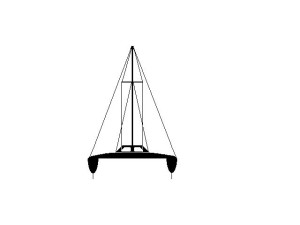Catamaran, Rifflart
31' x 16' x 4 Tons
9-Ft. Dia. BUORD
Force 9-10 Conditions
File D/C-2, obtained from John Kettlewell, Middle Grove, NY. - Vessel name Echo, catamaran, designed by Mark Louis Rifflart, LOA 31' 6" x Beam 16' x Draft 2' 8" x 4 Tons - Drogue: 9-Ft. diameter BUORD on 400' x 1/2" nylon three strand tether, with bridle arms of 25' each and 1/2" galvanized swivel - Deployed in a gale in deep water about 400 miles SW of Bermuda with winds of 40-50 knots and seas of 18-25 ft. - Vessel's stern yawed 10° - Drift was estimated to be about 30 nm during 20 hours of deployment.
Echo was en route to San Juan, Puerto Rico, from Beaufort, NC., when she ran into a gale. Her owner John Kettlewell is a marine consultant with a good deal of cruising experience. He has written numerous articles and was acquisitions editor for International Marine Publications for a while. (See also his article entitled, Rough Passage To San Juan appearing in the November/December 1991 issue of Multihulls Magazine).
Echo ran downwind for a while until it became unsafe to do so. She lay a-hull for a short period thereafter and Kettlewell deemed that just as unsafe - the occasional breaker would knock the bow off and she would surf sideways out of control.
He then deployed a 9-ft. BUORD parachute off the bow, his wife Leslie assisting. The 400 feet of line smoked out so quickly that they were barely able to cleat it before it reached the end. The 9-ft. diameter Naval Ordnance parachute (porous canopy) did not produce enough drag to keep the bows pointed into the seas - they were yawing up to 90° off to each side. So Kettlewell decided to switch ends and use it as a drogue off the stern instead.
This accomplished, the parachute then kept the stern pointed into the seas in a satisfactory way, with no further steering required. The crew was able to go down below and get some rest on the floor of the saloon area. Transcript:
In general we were very pleased with the performance of the drogue. As I stated previously we could not lie bow into the wind with this size chute. I wonder if we had removed our roller furling jib we could have laid bow to.... In any case I'm sure I would now prefer to run before the seas on this boat. Our cockpit is well protected with a strong door and great drainage due to the motorwell for the outboard. I think it is useful to give with the punches of the waves. We even raised our rudders to take the strain off of them from wave hits.... With a bridle to each stern the drogue held us straight on to the sea and we did not have to steer.
I am very wary of using a trip line as I find storms tend to make amazing tangles of even the simplest rigs. On the other hand, if something were to disable the chute suddenly, it would be very difficult to get it in and untangled during the height of a storm. However, even though it was extremely tiring and difficult to retrieve I still would not rig a trip line. We had some success using the motor to slowly power up to the drogue.
We had no problems with the line kinking or chafing. I used two 5/8" braided bridle lines led through clear PVC water tubing. Our rode consisted of 2 x 200' lengths of 1/2" nylon connected by a large shackle in the middle. I feel your length recommendations (i.e., LOA x 10) may be a bit short. I was certainly happy I had 400' of rode!
Love the Drag Device Database? Help us to keep it free for all mariners by making a tiny donation to cover our server and maintenance costs. Thank You!
